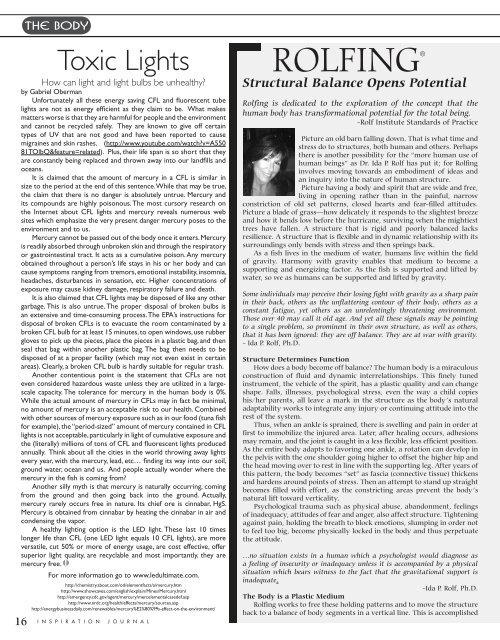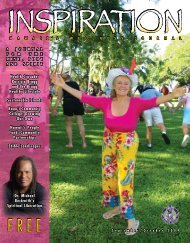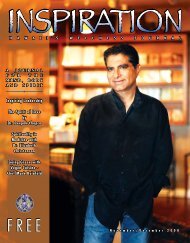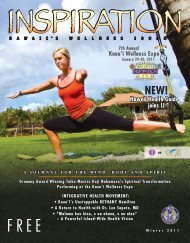Aloha Aloha - Inspiration Journal Magazine
Aloha Aloha - Inspiration Journal Magazine
Aloha Aloha - Inspiration Journal Magazine
You also want an ePaper? Increase the reach of your titles
YUMPU automatically turns print PDFs into web optimized ePapers that Google loves.
16<br />
the body<br />
Toxic Lights<br />
How can light and light bulbs be unhealthy?<br />
by Gabriel Oberman<br />
Unfortunately all these energy saving CFL and fluorescent tube<br />
lights are not as energy efficient as they claim to be. What makes<br />
matters worse is that they are harmful for people and the environment<br />
and cannot be recycled safely. They are known to give off certain<br />
types of UV that are not good and have been reported to cause<br />
migraines and skin rashes. (http://www.youtube.com/watch?v=A550<br />
81TOlbQ&feature=related). Plus, their life span is so short that they<br />
are constantly being replaced and thrown away into our landfills and<br />
oceans.<br />
It is claimed that the amount of mercury in a CFL is similar in<br />
size to the period at the end of this sentence. While that may be true,<br />
the claim that there is no danger is absolutely untrue. Mercury and<br />
its compounds are highly poisonous. The most cursory research on<br />
the Internet about CFL lights and mercury reveals numerous web<br />
sites which emphasize the very present danger mercury poses to the<br />
environment and to us.<br />
Mercury cannot be passed out of the body once it enters. Mercury<br />
is readily absorbed through unbroken skin and through the respiratory<br />
or gastrointestinal tract. It acts as a cumulative poison. Any mercury<br />
obtained throughout a person’s life stays in his or her body and can<br />
cause symptoms ranging from tremors, emotional instability, insomnia,<br />
headaches, disturbances in sensation, etc. Higher concentrations of<br />
exposure may cause kidney damage, respiratory failure and death.<br />
It is also claimed that CFL lights may be disposed of like any other<br />
garbage. This is also untrue. The proper disposal of broken bulbs is<br />
an extensive and time-consuming process. The EPA’s instructions for<br />
disposal of broken CFLs is to evacuate the room contaminated by a<br />
broken CFL bulb for at least 15 minutes, to open windows, use rubber<br />
gloves to pick up the pieces, place the pieces in a plastic bag, and then<br />
seal that bag within another plastic bag. The bag then needs to be<br />
disposed of at a proper facility (which may not even exist in certain<br />
areas). Clearly, a broken CFL bulb is hardly suitable for regular trash.<br />
Another contentious point is the statement that CFLs are not<br />
even considered hazardous waste unless they are utilized in a largescale<br />
capacity. The tolerance for mercury in the human body is 0%.<br />
While the actual amount of mercury in CFLs may in fact be minimal,<br />
no amount of mercury is an acceptable risk to our health. Combined<br />
with other sources of mercury exposure such as in our food (tuna fish<br />
for example), the “period-sized” amount of mercury contained in CFL<br />
lights is not acceptable, particularly in light of cumulative exposure and<br />
the (literally) millions of tons of CFL and fluorescent lights produced<br />
annually. Think about all the cities in the world throwing away lights<br />
every year, with the mercury, lead, etc… finding its way into our soil,<br />
ground water, ocean and us. And people actually wonder where the<br />
mercury in the fish is coming from?<br />
Another silly myth is that mercury is naturally occurring, coming<br />
from the ground and then going back into the ground. Actually,<br />
mercury rarely occurs free in nature. Its chief ore is cinnabar, HgS.<br />
Mercury is obtained from cinnabar by heating the cinnabar in air and<br />
condensing the vapor.<br />
A healthy lighting option is the LED light. These last 10 times<br />
longer life than CFL (one LED light equals 10 CFL lights), are more<br />
versatile, cut 50% or more of energy usage, are cost effective, offer<br />
superior light quality, are recyclable and most importantly, they are<br />
mercury free.<br />
For more information go to www.ledultimate.com.<br />
http://chemistry.about.com/od/elementfacts/a/mercury.htm<br />
http://www.showcaves.com/english/explain/Mines/Mercury.html<br />
http://emergency.cdc.gov/agent/mercury/mercelementalcasedef.asp<br />
http://www.nrdc.org/health/effects/mercury/sources.asp<br />
http://energybusinessdaily.com/renewables/mercury%E2%80%99s-effect-on-the-environment/<br />
i n s p i r a t i o n j o u r n a l<br />
ROLFING®<br />
Structural Balance Opens Potential<br />
Rolfing is dedicated to the exploration of the concept that the<br />
human body has transformational potential for the total being.<br />
-Rolf Institute Standards of Practice<br />
Picture an old barn falling down. That is what time and<br />
stress do to structures, both human and others. Perhaps<br />
there is another possibility for the “more human use of<br />
human beings” as Dr. Ida P. Rolf has put it; for Rolfing<br />
involves moving towards an embodiment of ideas and<br />
an inquiry into the nature of human structure.<br />
Picture having a body and spirit that are wide and free,<br />
living in opening rather than in the painful, narrow<br />
constriction of old set patterns, closed hearts and fear-filled attitudes.<br />
Picture a blade of grass—how delicately it responds to the slightest breeze<br />
and how it bends low before the hurricane, surviving when the mightiest<br />
trees have fallen. A structure that is rigid and poorly balanced lacks<br />
resilience. A structure that is flexible and in dynamic relationship with its<br />
surroundings only bends with stress and then springs back.<br />
As a fish lives in the medium of water, humans live within the field<br />
of gravity. Harmony with gravity enables that medium to become a<br />
supporting and energizing factor. As the fish is supported and lifted by<br />
water, so we as humans can be supported and lifted by gravity.<br />
Some individuals may perceive their losing fight with gravity as a sharp pain<br />
in their back, others as the unflattering contour of their body, others as a<br />
constant fatigue, yet others as an unrelentingly threatening environment.<br />
Those over 40 may call it old age. And yet all these signals may be pointing<br />
to a single problem, so prominent in their own structure, as well as others,<br />
that it has been ignored: they are off balance. They are at war with gravity.<br />
- Ida P. Rolf, Ph.D.<br />
Structure Determines Function<br />
How does a body become off balance? The human body is a miraculous<br />
construction of fluid and dynamic interrelationships. This finely tuned<br />
instrument, the vehicle of the spirit, has a plastic quality and can change<br />
shape. Falls, illnesses, psychological stress, even the way a child copies<br />
his/her parents, all leave a mark in the structure as the body’s natural<br />
adaptability works to integrate any injury or continuing attitude into the<br />
rest of the system.<br />
Thus, when an ankle is sprained, there is swelling and pain in order at<br />
first to immobilize the injured area. Later, after healing occurs, adhesions<br />
may remain, and the joint is caught in a less flexible, less efficient position.<br />
As the entire body adapts to favoring one ankle, a rotation can develop in<br />
the pelvis with the one shoulder going higher to offset the higher hip and<br />
the head moving over to rest in line with the supporting leg. After years of<br />
this pattern, the body becomes “set” as fascia (connective tissue) thickens<br />
and hardens around points of stress. Then an attempt to stand up straight<br />
becomes filled with effort, as the constricting areas prevent the body’s<br />
natural lift toward verticality.<br />
Psychological trauma such as physical abuse, abandonment, feelings<br />
of inadequacy, attitudes of fear and anger, also affect structure. Tightening<br />
against pain, holding the breath to block emotions, slumping in order not<br />
to feel too big, become physically locked in the body and thus perpetuate<br />
the attitude.<br />
…no situation exists in a human which a psychologist would diagnose as<br />
a feeling of insecurity or inadequacy unless it is accompanied by a physical<br />
situation which bears witness to the fact that the gravitational support is<br />
inadequate.<br />
-Ida P. Rolf, Ph.D.<br />
The Body is a Plastic Medium<br />
Rolfing works to free these holding patterns and to move the structure<br />
back to a balance of body segments in a vertical line. This is accomplished





